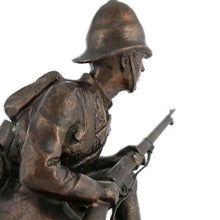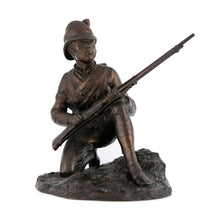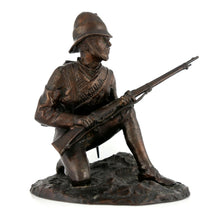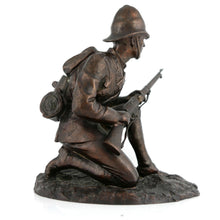Boer War Bronze Infantryman, 1899
Adding product to your cart
Height overall: 20cm (8in)
Patinated bronze. Modelled as a kneeling British infantryman of the Boer War in foreign service uniform comprising pith helmet with hackle, khaki drill and 1888 pattern Slade-Wallace equipment, Lee-Metford rifle, puttees and boots on naturalistic integral bronze base. Attributed to Henry Wilson of William Hutton & Sons of Sheffield.
Henry Edward Wilson (1882-1934) was born in Sheffield and trained at the Sheffield School of Art before joining the silversmiths William Huttons & Sons as a silver designer and modeller in 1896. By this time Huttons, established in Birmingham in 1800, employed some 500 workers in eight departments. Wilson worked under T. Swaffield Brown (1845-1914), who directed the firm’s art department from 1887. The firm’s output included figural work for several presitigious London firms through their trade only Farringdon showroom; these included The Goldsmiths & Silversmiths Company which was an important supplier of military silverware and one of the firms that applied its own maker’s marks to finished silver figures. Following the death of Herbert Hutton - a Colonel in the local volunteers and a boss who ‘never wasted a word … and was abrupt in manner’, at his mansion in 1904 (Sheffield Daily Telegraph, 8 June 1904), the firm’s fortunes went into a slow decline. In 1917 Henry Wilson found himself conscripted into the Royal Navy as Coppersmith in the Royal Naval Air Service. He became a Petty Officer but suffered ill health which dogged him for the rest of his life. After briefly returning to Huttons he was made redundant in 1922 and afterwards worked as freelance designer.








